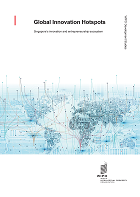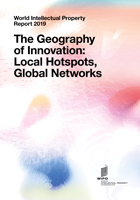Innovation Hotspots: The Rise of Singaporean Startups
Despite fierce competition, Singaporean startups are breaking barriers and driving technological advancements. From groundbreaking solutions to combatting COVID-19 to pioneering smart city infrastructure, Singapore's startup ecosystem is transforming industries and pushing boundaries.

The difficulties of locals to compete with foreign players
Despite a strong performance in terms of scientific output and R&D investment, patent applications substantial growth in the Singapore Innovation Hotspot is mainly due to foreign applications with only two local companies among the top 50 applicants, and solely one applied for more than 100 Singaporean patents. While this reflects the city-state's ability to attract overseas R&D, entrepreneurial talents and venture capital funding, the low growth of patent filings by indigenous companies is a symptom of the underdevelopment of their innovation capacity vis-à-vis foreign competitors. This situation seems to affect every component of the domestic private industrial ecosystem, including SMEs and large enterprises (both related and unrelated to government), but with the notable exception of start-ups.
Start-ups: Singapore's ace up its sleeve for national innovation
Over the 2000-2020 period, even if large local enterprises continued to generate more patents than start-ups, their patenting numbers have shown a declining trend while those for start-ups have shown a steady increase.
Moreover, the increasing applications of local start-ups are to be put in parallel with the evolution of the developed technologies. In the mid-2000s, Singapore was facing an overabundance risk of low-tech start-ups operating in the digital innovation space (internet/mobile/IT services). Furthermore, most of
them were founded by low educated entrepreneurs. However, it has been observed that a significant proportion are now operating in deep tech and are strongly related to academic research. Thus in 2016, patent applications of the city-state showed similar fields distributions to its London and New York counterparts, with 30% more Singaporean start-ups than London ones operating in deep technology fields (i.e. biomedical or clean energy). In this sense, along with public sector organizations (PRIs and universities), start-ups are a critical part of local innovation. For instance, during the Covid-19 crisis, it was a local wireless technology start-up called iWow, which quickly deployed a contact-tracing device for large-scale deployment among Singapore’s resident population and successfully contain the spread of Covid-19.
Source: Tech@SG
The need and challenges for tailoring public policies to the innovation ecosystem
If this success results of private initiatives, public intervention, both on the demand and supply side, has been critical to compensate for market failure and for the need of a lead user, as highlighted by the World Bank review of Singapore’s start-up ecosystem. The support for local tech entrepreneurs originated as soon as 1999 through a 1 billion US dollar investment fund to match investment in start-ups by angel investors. Public investments have been continued through significant public spending in key innovation clusters such as smart city infrastructure and healthcare, which seems to have contributed to the growth of innovative activities of indigenous start-ups. The development of academic research and the training of qualified entrepreneurs accompanied the financial efforts, both of which are necessary for the incubation of innovative deep tech start-ups.
This success, however, remains in half tone and Singapore still faces sizeable challenges. Although the start-up ecosystem seems to be succeeding in its transition towards more valuable complex technologies, these are still predominantly on the internet, mobile, or IT services sectors; and only a minority of the deep-tech ones “scaled ups” with the potential to become globally leading high-tech firms.
Furthermore, due to the low absorptive capacities of the existing local enterprises that remains to be developed, translation of public investment into technology commercialization remains limited, hence the necessity of public interventions on the demand side. If Singapore seems to be succeeding in the development of innovative entrepreneurial activities, the relative prowess of Singapore start-ups won’t be enough to compensate for the lack of innovative capability of large incumbent firms and various quasi–state-owned enterprises. Without significant efforts in this direction, it seems unlikely that domestic innovators will succeed in imposing themselves on foreign competitors and will be able to make the most upstream investment efforts in R&D and scientific production.
Related Stories

Innovation Hotspots: The Singaporean Recipe for Development
Singapore’s policymakers have played a significant role in helping the state transition into a high-income economy in less than forty years. Learn about which policies proved to be the most effective!

Innovation Hotspots: How Policy May Redirect Innovation
Government policies can affect the rate and, to some extent, the direction of innovative activities. Some of these policies, such as R&D tax incentives, protection of intellectual property (IP) rights, encourage innovation.

